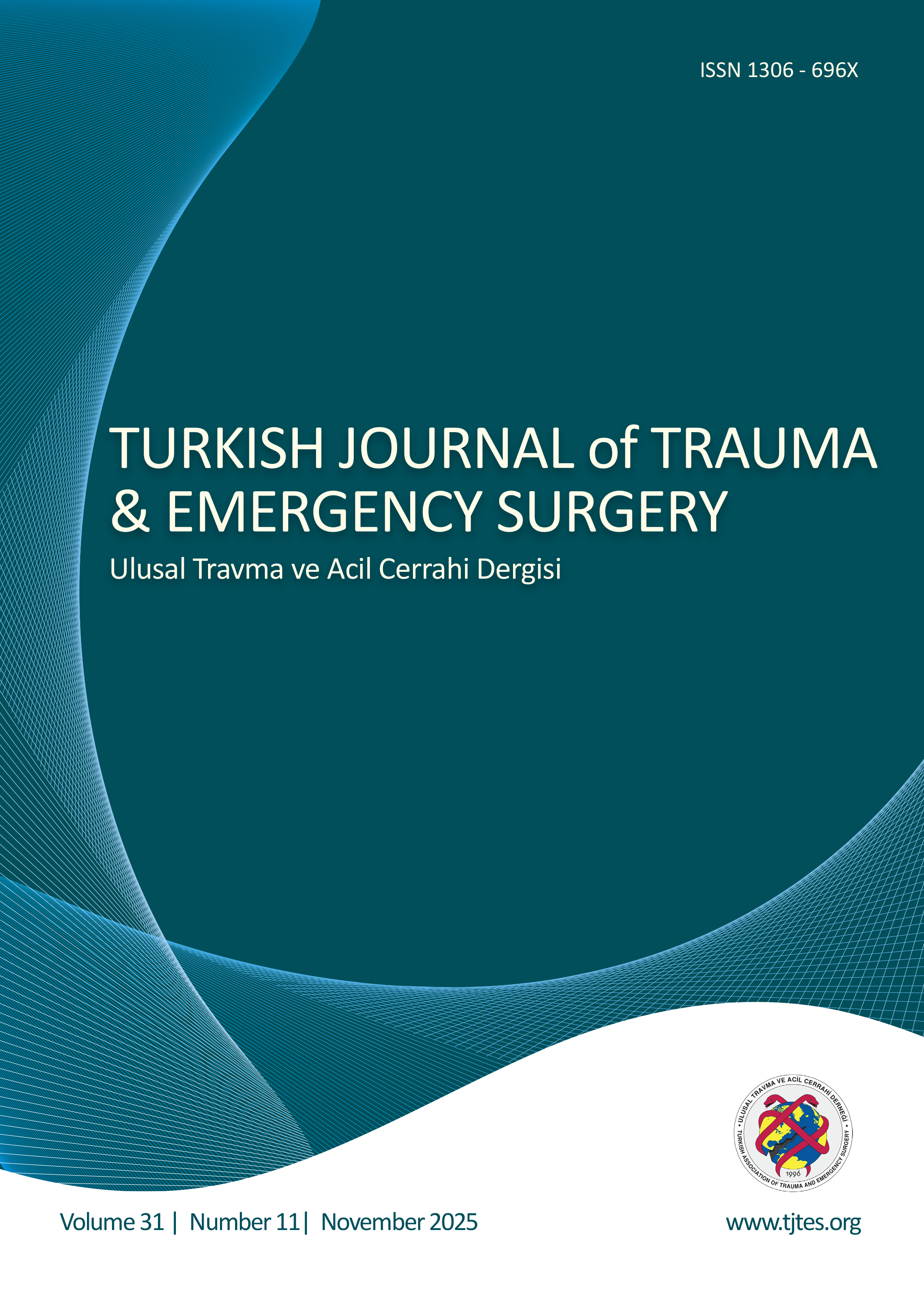Hızlı Arama
Boğaz ağrısı ve boyun ağrısı olan hastalarda derin boyun enfeksiyonu için risk faktörleri
Seong In Hong1, Dong Hoon Lee2, Ho Sub Chung2, Yoon Hee Choi1, Sung Jin Bae21Ewha Womans Üniversitesi Mokdong Hastanesi, Acil Tıp Bölümü, Seoul, Güney Kore2Gwangmyeong Üniversitesi Gwangmyeong Hastanesi, Acil Tıp Bölümü, Seoul, Güney Kore
AMAÇ: Derin boyun enfeksiyonu (DBE), enfeksiyonun hızla yayılarak ciddi komplikasyonlara neden olma ihtimalinden dolayı potansiyel olarak yaşamı tehdit eden bir durumdur. Bu nedenle, diğer boyun enfeksiyonlarından daha fazla dikkat gerektirir. Ancak COVID-19 pandemisi döneminde izolasyon yönergeleri nedeniyle birçok zorluk yaşanmıştır. Acil serviste ilk karşılaşıldığında var olan hasta semptomları aracılığıyla DBEnun erken öngörülebilirliğini araştırdık.
GEREÇ VE YÖNTEM: Bu çalışma, Ocak 2016dan Şubat 2021e kadar yumuşak doku boyun enfeksiyonu şüphesi olan hastaların retrospektif bir incelemesidir. Semptomlar; ateş, yabancı cisim hissi, göğüs rahatsızlığı/ağrı, submandibular ağrı, odinofaji, disfaji, ses değişikliği ve şiddetli ağrı olarak geriye dönük analiz edildi. Ayrıca temel karakteristik veriler, laboratuvar bulguları ve prevertebral yumuşak doku (PVYD) kalınlığı değerlendirildi. Bilgisayarlı tomografi (BT) ile DBE ve diğer boyun enfeksiyonları teşhis edildi. Derin boyun enfeksiyonunu öngörmek üzere bağımsız faktörleri belirlemek için lojistik regresyon analizi yapıldı.
BULGULAR: Çalışmaya alınan 793 hastanın 267sine (%33.7) DBE, 526sına (%66.3) diğer yumuşak doku boyun enfeksiyonları tanıları konuldu. İki grup arasındaki karşılaştırmada, C-reaktif protein (CRP), sodyum, PT (INR), yabancı cisim hissi, göğüs rahatsızlığı/ağrı, submandibular ağrı, odino-faji, disfaji, şiddetli ağrı ve PVYD kalınlığı, istatistiksel olarak anlamlı farklılık gösterdi. Derin boyun enfeksiyonunu öngörmek için bağımsız faktörler; semptomlar arasından şiddetli ağrı (odds ratio: 6.336 (3.63511.045), p<0.001), yabancı cisim hissi (odds ratio: 7.384 (2.77619.642), p<0.001), submandibular ağrı (odds ratio: 4.447 (2.8526.932), p<0.001) ve disfaji (odds ratio: 52.118 (8.662 313.588), p<0.001) ve laboratuvar testleri arasından CRP (odds ratio: 1.034 (1.0041.065), p=0.026) ve PT (INR) (odds ratio: 29.660 (3.363 261.598), p=0.002) idi. C2 seviyesindeki (odds ratio: 1.953 (1.6092.370), p<0.001) ve C6 seviyesindeki (odds ratio: 1.179 (1.0541.319), p=0.004) PVYD kalınlığı da öngörü için bağımsız birer değişken olarak gösterildi.
TARTIŞMA: Boğaz ağrısı veya boyun ağrısı olan hastalarda disfaji, yabancı cisim hissi, şiddetli ağrı ve submandibular ağrısı olanların DBE olma olasılığı daha yüksektir. Derin boyun enfeksiyonu ciddi komplikasyonlara neden olabilir; bu nedenle, yukarıdaki semptomlara sahip hastalar önemli kompli-kasyon potansiyeli nedeniyle yakından izlenmelidir.
Anahtar Kelimeler: Acil servis, belirti ve bulgular, boğaz ağrısı, COVID-19; derin boyun enfeksiyonu; gecikmiş tedaviler.
Risk factors for deep neck infection in patients with sore throat and neck pain
Seong In Hong1, Dong Hoon Lee2, Ho Sub Chung2, Yoon Hee Choi1, Sung Jin Bae21Department of Emergency Medicine, Ewha Womans University Mokdong Hospital, College of Medicine, Seoul, Republic of Korea2Department of Emergency Medicine, Chung-Ang University Gwangmyeong Hospital, College of Medicine, Seoul, Republic of Korea
BACKGROUND: Deep neck infection (DNI) is a potentially life-threatening disease because infections spread quickly, causing se-rious complications. Therefore, more attention is needed than other neck infections, but there are many difficulties due to isolation guidelines in the period of coronavirus disease 2019 pandemic. We investigated the early predictability of DNI through patient symptoms at the first emergency department encounter.
METHODS: This was a retrospective study of patients with suspected soft-tissue neck infections from January 2016 to February 2021. Symptoms were retrospectively analyzed in fever, foreign body sensation, chest discomfort/pain, submandibular pain, odynopha-gia, dysphagia, voice change, and severe pain. Furthermore, baseline characteristic data, laboratory findings, and pre-vertebral soft-tissue (PVST) thickness were evaluated. DNI and other neck infections were diagnosed through computed tomography. Logistic regression analysis was conducted to determine the independent factors for predicting DNI.
RESULTS: In the 793 patients included in the study, 267 (33.7%) were diagnosed with DNI, and 526 (66.3%) were diagnosed with other soft-tissue neck infections. In the comparison between the two groups, C-reactive protein (CRP), sodium, PT (INR), foreign body sensation, chest discomfort/pain, submandibular pain, odynophagia, dysphagia, severe pain, and PVST thickness showed statisti-cally significant differences. Independent factors for predicting DNI were severe pain (odds ratio: 6.336 [3.63511.045], p<0.001), for-eign body sensation (odds ratio: 7.384 [2.77619.642], p<0.001), submandibular pain (odds ratio: 4.447 [2.8526.932], p<0.001), and dysphagia (odds ratio: 52.118 [8.662313.588], p<0.001) among symptoms and CRP (odds ratio: 1.034 [1.0041.065], p=0.026) and PT (INR) (odds ratio: 29.660 [3.363261.598], p=0.002) in laboratory tests. PVST thickness at C2 (odds ratio: 1.953 [1.6092.370], p<0.001) and C6 level (odds ratio: 1.179 [1.0541.319], p=0.004) was also shown as an independent variable for prediction.
CONCLUSION: Among patients with sore throat or neck pain, patients with dysphagia, foreign body sensation, severe pain, and submandibular pain are more likely to have DN. DNI can cause serious complications; therefore, patients with the above symptoms should be closely observed due to the potential for significant complications.
Keywords: COVID-19, deep neck space infection, delayed treatments, emergency department; signs and symptoms; sore throat.
Makale Dili: İngilizce





